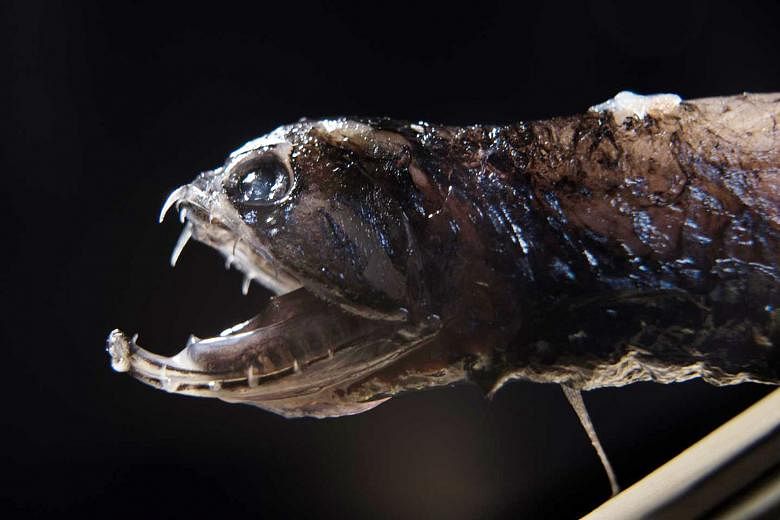Unassuming dragonfish lurk in the twilight zone, more than 488m under the surface of the ocean.
Dark, eel-like and roughly 9cm long, these deep-sea creatures glow with bioluminescence and have evolved a complex sensory system that allows them to detect even the subtlest movements in the ocean's shadowy realms, then attract and capture their prey.
In a paper published in the journal Matter, scientists demonstrated another layer of complexity to the dragonfish - the thin, jagged teeth of the Aristostomias scintillans species are made of nanoscale-size crystal particles. The composition and structure of these nanocrystals make the dragonfish's fangs transparent and stronger than the teeth of some of the fiercest fish predators, such as great white sharks and piranhas.
The new findings have intrigued both marine biologists and material scientists. Dragonfish are not strong swimmers, so researchers have long wondered how they eat.
"They're basically hanging out in the water column," said Professor Jacqueline Webb, a fish biologist at the University of Rhode Island. "Because they cannot be studied alive in the laboratory, any observation that can lend insights into the biology of these fishes is really valuable."
And for material scientists, understanding the details of dragonfish teeth could help lead to new synthetic materials that are strong and transparent, said Professor Emanuela Del Gado, a material physicist at Georgetown University, in Washington. Neither she nor Prof Webb were involved in the study.
Dr Marc A. Meyer, lead author of the new paper and a materials scientist at the University of California, San Diego, has long studied animals for inspiration to develop novel materials.
In the beaks of toucans, the shells of abalones and leatherback turtles, and the scales of pangolins and alligators, he has discovered structures that, when synthesised or mimicked in the lab, could have potential real-world applications.
In 2017, Dr Meyer visited Dr Dimitri Deheyn of the Scripps Institution of Oceanography in San Diego.
Dr Deheyn, who studies bioluminescence, had come across dragonfish and wondered why they had transparent teeth. Dr Meyer was equally intrigued when he inspected Dr Deheyn's frozen deep-sea fish collection, which included the ghastly-looking hatchetfish and wide-faced ratfish.
Dr Deheyn chopped off the head of one dragonfish and gave a sample to Dr Meyer to analyse at the Leibniz Institute for New Materials in Saarbrucken, Germany.
When Dr Meyer and his colleagues at the institute used electron microscopy to take a closer look at the teeth, they were surprised to discover tiny crystals - ranging from 5 nanometres to 20 nanometres in diameter - embedded throughout the teeth.
"At first, we thought that it was some type of glass," Dr Meyer said.
The structure differed from the enamel in human teeth.
The composition of these nanocrystals make the teeth not only strong but also transparent. Dragonfish may have evolved such teeth to help them become effective predators.
Prof Webb said: "Their wide-open mouth, armed with transparent, saber-like teeth, effectively disappear in the surrounding blackness."
The nanocrystals identified in the hooked teeth of the dragonfish may serve as a template for new materials that are both transparent and mechanically strong, said Dr Chang Chih-hao, who studies bioinspired nanostructures at North Carolina State University, in Raleigh.
"Biomimetics has provided many inspirations for engineers and this is yet another great example," he said. "It just goes to show how beautiful nature is all around us and it can be really rewarding to take a closer look."
NYTIMES

